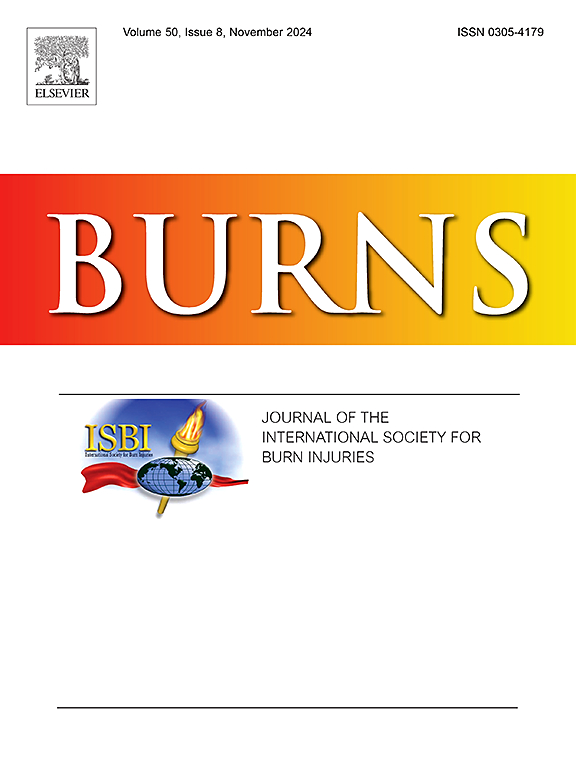前300名接受菠萝蛋白酶酶清创治疗的患者的单中心经验
IF 3.2
3区 医学
Q2 CRITICAL CARE MEDICINE
引用次数: 0
摘要
本回顾性队列研究评估了2015年至2020年在我院烧伤科治疗的烧伤患者使用Nexobrid®进行酶清创(ED)的临床结果。主要目的是确定Nexobrid®是否有效地减少不必要的手术并改善患者的预后。方法本研究纳入300例18岁以上深部皮肤和全层烧伤患者,不包括化学/电烧伤、妊娠和对Nexobrid®过敏的病例。入院时评估烧伤深度,ed后重新评估。主要终点是与传统临床评估相比,ED在确定手术指征方面的可靠性。次要终点包括影响愈合时间、并发症发生率和疤痕肥大的因素。结果300例患者中,男性76 %,中位年龄41岁,以火焰烧伤最为常见(46.7 %)。烧伤的中位总体表面积(TBSA)为8 %,用Nexobrid®治疗的TBSA为5 %。对26例大面积烧伤患者进行序贯ED治疗。治疗后的数据表明,与最初的评估相比,ED改善了烧伤深度的诊断,通常降低了皮肤烧伤的分期。“步征”作为一种有用的预测皮肤烧伤移植手术必要性的指标。烫伤与火焰烧伤在ED效果上无显著差异。ED与失血有关,强调TBSA高的病例要谨慎,早期发热被认为是需要警惕监测的因素。虽然疤痕肥大与手术有关,但本研究设计不能直接评估ED对瘢痕肥大的影响。结论:我们发现ED是一种可靠的快速清除痂和准确评估烧伤深度的方法,这通常有助于我们避免不必要的手术,特别是在脆弱的功能区域,如上肢。有趣的是,在治疗中深度损伤时,ED的效果不受烧伤病因的影响。虽然ED似乎不会增加感染的风险,但早期发烧仍应仔细监测。随着时间的推移,ED已经成为我们烧伤治疗方案的核心工具。需要进一步的研究来探索其对大面积烧伤患者的治疗作用。本文章由计算机程序翻译,如有差异,请以英文原文为准。
Single center experience of the first 300 patients treated with bromelain-based enzymatic debridement
Background
This retrospective cohort study evaluates the clinical outcomes of enzymatic debridement (ED) with Nexobrid® in burn patients treated at our hospital’s Burn Unit from 2015 to 2020. The primary aim was to determine whether Nexobrid® effectively reduces unnecessary surgeries and improves patient outcomes.
Methods
The study included 300 patients over 18 years old with deep dermal and full-thickness burns, excluding cases with chemical/electrical burns, pregnancy, and allergies to Nexobrid®. Burn depth was assessed upon admission and re-evaluated post-ED. The primary endpoint was the reliability of ED in determining surgical indications compared to traditional clinical assessments. Secondary endpoints included factors influencing healing time, complication rates, and scar hypertrophy.
Results
Among the 300 patients (76 % male, median age 41), flame burns were most common (46.7 %). Median total body surface area (TBSA) burned was 8 %, and TBSA treated with Nexobrid® was 5 %. Sequential ED was performed in 26 patients with larger burns.
Post-treatment data indicated that ED improved burn depth diagnosis compared to initial assessments, often downstaging dermal burns. The “step sign” emerged as a useful predictor for graft surgery necessity in dermal burns. No significant differences were observed between scald and flame burns in ED effectiveness. ED was associated with blood loss, emphasizing caution in cases with high TBSA, and early fever was noted as a factor requiring vigilant monitoring. While scar hypertrophy was associated with surgery, this study design could not directly evaluate ED's impact on hypertrophy.
Conclusion
We found ED to be a reliable method for rapid eschar removal and accurate burn depth evaluation, which often helped us avoid unnecessary surgeries—particularly important in delicate, functional areas like the upper limbs. Interestingly, the effectiveness of ED was not influenced by the burn’s etiology when treating intermediate-depth injuries. While ED does not appear to rise the risk of infection, early fever should still be carefully monitored. Over time, ED has become a central tool in our burn treatment protocols. Future studies are needed to explore its impact on treating patients with extensive burns.
求助全文
通过发布文献求助,成功后即可免费获取论文全文。
去求助
来源期刊

Burns
医学-皮肤病学
CiteScore
4.50
自引率
18.50%
发文量
304
审稿时长
72 days
期刊介绍:
Burns aims to foster the exchange of information among all engaged in preventing and treating the effects of burns. The journal focuses on clinical, scientific and social aspects of these injuries and covers the prevention of the injury, the epidemiology of such injuries and all aspects of treatment including development of new techniques and technologies and verification of existing ones. Regular features include clinical and scientific papers, state of the art reviews and descriptions of burn-care in practice.
Topics covered by Burns include: the effects of smoke on man and animals, their tissues and cells; the responses to and treatment of patients and animals with chemical injuries to the skin; the biological and clinical effects of cold injuries; surgical techniques which are, or may be relevant to the treatment of burned patients during the acute or reconstructive phase following injury; well controlled laboratory studies of the effectiveness of anti-microbial agents on infection and new materials on scarring and healing; inflammatory responses to injury, effectiveness of related agents and other compounds used to modify the physiological and cellular responses to the injury; experimental studies of burns and the outcome of burn wound healing; regenerative medicine concerning the skin.
 求助内容:
求助内容: 应助结果提醒方式:
应助结果提醒方式:


